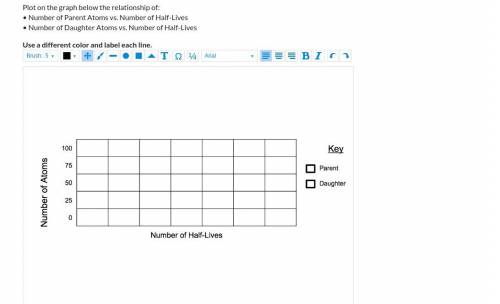angelaencinas90
10.11.2020 •
Mathematics
Radioactive dating is a technique used to date specimens of igneous rock. Elements vary in form based on the difference in the number of neutrons in the atom’s nucleus. These various forms are called isotopes. Some isotopes are radioactive and can be used to date rocks using their known half-life, the amount of time for the original number of atoms to fall to half its original value. Different minerals contain different radioactive isotopes. Once the rock has cooled, radioactive decay begins, and the original, or parent, atoms begin to decay and form daughter atoms. The parent-to-daughter proportion of atoms in a substance can tell us how many half-lives have occurred. The number of half-lives is multiplied by the length of one half-life, and the age of the substance is revealed. The chart below shows the parent isotopes, daughter isotopes, and the half-life of the parent isotopes.





Solved
Show answers
More tips
- G Goods and services LED-подсветка в LCD-телевизорах: 5 причин, почему она лучше других технологий...
- P Photography and Videography Understanding HDR: How It Works and Why You Need It...
- P Photography and Videography How to Choose the Perfect Photo Paper for Your Images?...
- C Computers and Internet How to Choose an Uninterruptible Power Supply (UPS) for Your Computer: Expert Tips...
- S Science and Technology How to choose a home theater system?...
- A Auto and Moto How to Choose a Car Wash? Tips and Recommendations...
- A Animals and plants How ants survive winter: exploring the secrets of their winter life...
- C Construction and repair How to Choose the Best Underfloor Heating?...
- S Sport When is the Champions League final?...
- S Sport When and Where Will the 2014 World Cup be Held?...
Answers on questions: Mathematics
- M Mathematics Is one over one-third a unit rate...
- M Mathematics You decide to go to the candy store in the mall. You arrive at the store with $25 and then purchase 3 candy bars. You then buy a giant candy snake for $12.50. When you leave,...
- M Mathematics Hi, please help with the exponent rules and explain them to me I included a picture!!! It s worth a lot of points...
- M Mathematics .Write an expression using fractions to show how to determine the amount that each person will pay. Then calculate each person s contributions showing all steps in long division....
- M Mathematics After striking a pair of arcs from each endpoint of a line segment, what is the next step in constructing the segment s perpendicular bisector? Use a protractor to draw a 90°....
- M Mathematics Se quiere diseñar una ventana como la de la figura, siendo el triángulo superior un triángulo equilátero y su perímetro 10 m. Determinar las dimensiones para que entre la mayor...
- M Mathematics Which is smaller, -5 or 7...
- M Mathematics A model of a lighthouse is 2 inches wide at its base and 6 inches tall. If the actual lighthouse is 30 feet wide, what is the approximate height of the lighthouse?...
- M Mathematics 1 The cost, C of producing g units of a water bottles consists of two parts. There is a fixed cost of $808, plus a variable cost of $7 per unit produced. Which equation gives...
- M Mathematics Which of the following expressions represents the difference of 8 and nwhich of the following expression does not represent for more than one third x...

Ответ:
im not that smart
Step-by-step explanation: